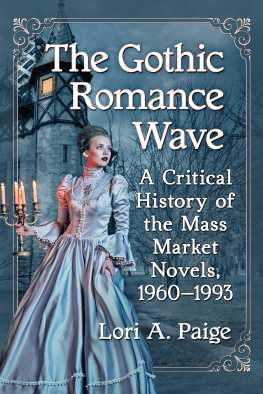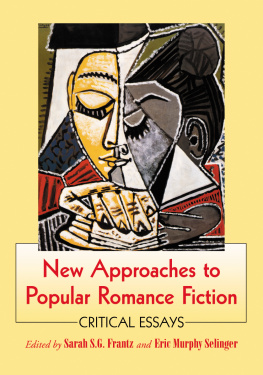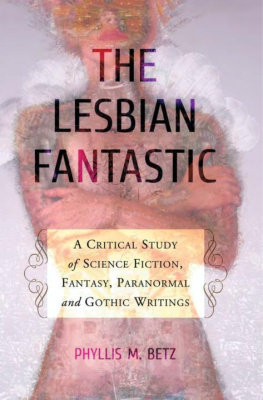
Also by PHYLLIS M. BETZ
AND FROM MCFARLAND
The Lesbian Fantastic: A Critical Study of Science Fiction, Fantasy, Paranormal and Gothic Writings (2011)
Lesbian Romance Novels: A History and Critical Analysis (2009)
Lesbian Detective Fiction: Woman as Author, Subject and Reader (2006)
Katherine V. Forrest
A Critical Appreciation
PHYLLIS M. BETZ

McFarland & Company, Inc., Publishers
Jefferson, North Carolina
LIBRARY OF CONGRESS CATALOGUING DATA ARE AVAILABLE
BRITISH LIBRARY CATALOGUING DATA ARE AVAILABLE
e-ISBN: 978-1-4766-2819-6
2017 Phyllis M. Betz. All rights reserved
No part of this book may be reproduced or transmitted in any form or by any means, electronic or mechanical, including photocopying or recording, or by any information storage and retrieval system, without permission in writing from the publisher.
Front cover image of tree and knowledge 2017 BrianAJackson/iStock
McFarland & Company, Inc., Publishers
Box 611, Jefferson, North Carolina 28640
www.mcfarlandpub.com
For Bernice,
taken too soon
Acknowledgments
First, and foremost, I must thank Katherine V. Forrest for her willingness to answer my questions. She has always been gracious in responding quickly and many times answering the questions I did not ask.
Roz Miller continues to be a meticulous proofreader, not only catching the grammatical and mechanical mistakes, but in reminding me to keep the academic language to a minimum.
As always, Joan has been my strongest support; her willingness to let me take the time to read, research, and write cannot be measured.
Preface
From her groundbreaking lesbian romance novel Curious Wine to the Kate Delafield police procedural series, to the Coral Dawn science fiction trilogy, Katherine V. Forrest has become a representative voice in each major category of lesbian genre fiction. In the pages of her fiction, Forrest has offered groundbreaking portraits of lesbian life and experience; her work has also revealed the dangers faced by lesbians and gay men for asserting their right to live their lives fully and openly. Her novels have integrated the history of lesbians and gays into the narratives as well as the way cultural shifts have impacted the ways the LGBTQ community has reimagined itself.
As of this writing, no full-length examinations of Forrests work and its impact and influence for writers and readers of lesbian genre fiction is available. Her work has been examined in a range of critical articles and in passing in book-length critical studies on the detective genre and/or women writers of detective fiction. Most of these examinations, perhaps not surprisingly, have focused on her police novels featuring Kate Delafield since this series represents the majority of Forests literary output. Some critical attention has been given to the romance novels. My study hopes to position Forrest and her works within two major critical categories: popular fiction and how genre texts work as cultural mechanisms and illustrations of cultural shifts. In addition, I examine how Forrests works embody the history of lesbian and gay people as well as investigate how these texts connect to current queer theory.
Forrest has not only consciously utilized genre forms throughout her writing career, but used those forms to articulate a response to the stereotypic views of lesbian (and gay) experience. In an autobiographical piece written for the Harrington Lesbian Fiction Quarterly, Forrest asserts, [M]y work has represented the growth of a community, and of a writer. My work has presented in an entertaining format (I trust) many of the issues important to my community (10). This statement identifies the intersection of narrative form and thematic intent as well as the relationship that genre texts have with the wider world and experience of their readers. When the genre text accomplishes these dual purposes well, as Forrests work does, the reader connects to the text in interlocking ways; the enjoyment of the genre itselfwhether mystery, romance, or science fictionprovides an entry point to the more serious issues often raised in the story. Readers, of course, have the choice of stopping at merely reading for the pleasure of the narrative, working its ways through particular requirements of the genre, without any engagement with the deeper implications; however, when the author utilizes the generic forms to situate the story within a particular social environment or moment of cultural shift, the reader is allowed to use the text as a springboard for evaluating the broader implications offered by the narrative.
My study traces this movement of the integration of social and political issues that have confronted lesbians and gays throughout the second half of the twentieth century and into the current century over the course of Forrests writing career in the genre format. Forrests novels have, from the first, presented a deliberate use of a genres technical requirements to present, comment on, and critique the various social forces that negatively impact her characters lives. As an author of popular novels, Forrest has honed the skills of creating genre texts that entertain and educate the reader. She is a skillful writer who successfully balances both purposes. In fact, Forrest herself has frequently noted that she writes novels that address the specific interests and concerns of lesbian readers. At various times in her life, Forrest has also served as the editor for noted lesbian presses, including Naiadthe first to publish exclusively lesbian popular texts. Through such work Forrest has supported the writing careers of other lesbian authors, which has helped develop a thriving lesbian literary marketplace.
Forrest has a strong understanding that her work is part of a literary history, and I briefly discuss the history of popular lesbian literature, beginning with the pulp fiction of the 1950s and early 1960s. The importance of such texts to Forrest appears in articles she has written and in her editing of an anthology, Lesbian Pulp Fiction: The Sexually Intrepid World of Lesbian Paperback Novels 19501965, published by Cleis Press in 2005. These books not only provide a framework for specific examination of Forrests romance novels, they also illustrate the subversive nature of Forrests major themes throughout her various genre works. As American societys attitudes toward lesbians and gay men shifted, Forrest has used her characters and their stories to reflect such changes.
The major focus of my analysis centers on each genre category used by Forrestromance, mystery/detective, and science fiction. Each section looks closely at the particular narrative structure, characters, and thematic contexts. Since the Kate Delafield series represents most of Forrests work, more space is given to these novels. My intent is to consider not only the texts themselves, and how they embody generic conventions, but to look at the broader contexts within which the works are placed. The Delafield novels, particularly, engage with important ideological issues and historical events. As Kate herself ages, she must confront the changing social landscapes in which she moves. Forrest delineates a shifting world as well as the nuances of Kates responses. Forrest opens up a deeper understanding of Kates private world and presents the character finding ways to maneuver through the sometimes-unnerving impact of these changes. One of Forrests best-known works is the groundbreaking romance novel
Next page













